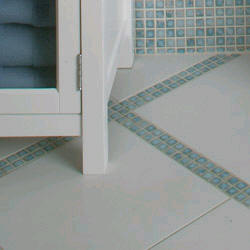Not all ceramic tiles are produced in the same manner nor do they have the same wear qualities. It is important that you understand what you are buying before you pay for it.

Figure 1 - Ceramic tile in a bathroom
Tiles are a produced by mixing a variety of different clays. These clays are then pressed into numerous different shapes and sizes and then fired (baked) at very high temperatures. It is the firing that gives ceramic tile it’s hardness. The bisque (body) of ceramic tile may then be painted and/or glazed, or left unglazed depending on it’s intended use.
Classifications of Ceramic Tile
Wear Ratings from the Porcelain Enamel Institute (P.E.I.):
- Group I: Tiles that are suitable for residential bathrooms with light foot traffic. Generally wall tile products fall into this group. Some wall tiles can be used on the floor. Consult the manufacturer of the tile for their recommended areas of application.
- Group II: Tiles that can be used in residential areas, but not areas with high foot traffic, such as in kitchens, foyers, laundry rooms, etc.
- Group III: Tiles that are recommended for all residential installations with normal foot traffic.
- Group IV: Tiles that are suited for light to medium commercial applications, such as offices, sales rooms.
- Group V: Tiles used in heavy commercial traffic areas and are suited for exterior areas, shopping centers, airports, hotel lobbies, public walkways.
Types of Tiles:
- Ceramic Mosaic Tile – tiles that are less than 6 inches facial area and may be either porcelain or natural clay composition and usually are 3/8 inch or less in thickness.
- Quarry Tile – tiles made from the extrusion process from shale or natural clays and usually are 6 square inches or more in facial size and can be glazed or unglazed.
- Paver Tile – glazed or unglazed natural clay or porcelain tiles having a facial area of six square inches or more and made from the dust-pressed method.
- Wall Tile – glazed tiles with that are designed for indoor use and are generally non-vitreous.
Common Tile Terms:
- Glazed – The most common style today in floor and wall tiles, as well as for residential and commercial applications. A liquid glass is applied to the body of the tile and fired at high temperatures. The glazing becomes hard and non-porous resulting in a flooring that is:
- Stain Resistant
- Scratch Resistant
- Fire Resistant
- Doesn’t Fade from Sun Light
- Slip Resistant
- Easy to Clean
Shiny glazes are softer, can be scratched easier, and can be slippery than the satin or rustic finishes.
